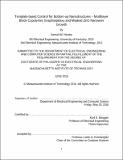| dc.contributor.advisor | Karl K. Berggen. | en_US |
| dc.contributor.author | Nicaise, Samuel M. (Samuel Mospens) | en_US |
| dc.contributor.other | Massachusetts Institute of Technology. Department of Electrical Engineering and Computer Science. | en_US |
| dc.date.accessioned | 2016-12-22T15:16:04Z | |
| dc.date.available | 2016-12-22T15:16:04Z | |
| dc.date.copyright | 2016 | en_US |
| dc.date.issued | 2016 | en_US |
| dc.identifier.uri | http://hdl.handle.net/1721.1/105949 | |
| dc.description | Thesis: Ph. D., Massachusetts Institute of Technology, Department of Electrical Engineering and Computer Science, 2016. | en_US |
| dc.description | This electronic version was submitted by the student author. The certified thesis is available in the Institute Archives and Special Collections. | en_US |
| dc.description | Cataloged from student-submitted PDF version of thesis. | en_US |
| dc.description | Includes bibliographical references. | en_US |
| dc.description.abstract | Directed self-assembly (DSA) mutually benefits both bottom-up growth and top-down nanofabrication. This thesis investigates templated control over the alignment and morphology of two bottom-up nanostructures, ZnO nanowires (NWs) and cylinder-forming block copolymers (BCPs). Despite material differences, we highlight their analogous nature by applying similar engineering principles to both - structure and spatial design, systematic energy manipulation, and process-specific functionality. These engineering principles were fundamental to the thesis research, and could be applicable other directed self-assembly systems. Also, bottom-up growth provides a parallel process for fabricating high-resolution, functional nanostructures which are otherwise difficult or too time-consuming to produce with top-down fabrication. The DSA of BCPs in this thesis used cylinder-forming poly(styrene-b-dimethylsiloxane) (PS-b-PDMS), which forms in-plane cylinders of an PDMS after annealing and etching. The final line arrays can be high-resolution and well-defined, though they may suffer from poor long-range order. Many previous topographical templating methods have left behind unwanted patterning features and only oriented BCPs in the same direction as the template. This thesis aimed to overcome those limitation. The orthogonal self-assembly method used a bottom layer line array template to direct the orthogonal alignment of top-layer BCP cylinders, providing sub-10-nm nanomeshes with local control and over large areas. The other method, shear alignment by mismatch in the thermal coefficient of expansion, oriented BCP cylinders based on cracks in a top layer of silicon dioxide due to shear stress in the BCP film. The templated growth of ZnO nanowires in this thesis emphasized controlling the placement, morphology, and alignment of the NWs for solar cell applications. Single crystal, semiconducting ZnO NWs can be grown in a parallel, hydrothermal process, though the placement, density, morphology, and alignment can be difficult to control without templating. Electron-beam lithography-fabricated masks of holes and gratings, on different substrates, were investigated by varying templating hole diameter and other experimental parameters. We engineered the placement, alignment, branching, and length of the NWs with this DSA approach. The lithographic fabrication was expanded to square-mm-areas to investigate local charge collection and internal quantum efficiency for NW pitches of 100-1000 nm in research-scale solar cell devices. | en_US |
| dc.description.statementofresponsibility | by Samuel M. Nicaise. | en_US |
| dc.format.extent | 222 pages | en_US |
| dc.language.iso | eng | en_US |
| dc.publisher | Massachusetts Institute of Technology | en_US |
| dc.rights | M.I.T. theses are protected by copyright. They may be viewed from this source for any purpose, but reproduction or distribution in any format is prohibited without written permission. See provided URL for inquiries about permission. | en_US |
| dc.rights.uri | http://dspace.mit.edu/handle/1721.1/7582 | en_US |
| dc.subject | Electrical Engineering and Computer Science. | en_US |
| dc.title | Template-based control for bottom-up nanostructures - multilayer block copolymer graphoepitaxy and masked ZnO nanowire growth | en_US |
| dc.type | Thesis | en_US |
| dc.description.degree | Ph. D. | en_US |
| dc.contributor.department | Massachusetts Institute of Technology. Department of Electrical Engineering and Computer Science | |
| dc.identifier.oclc | 965376589 | en_US |
